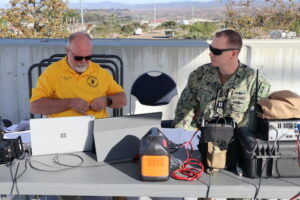
Story by Curtis Hill
Naval Hospital Camp Pendleton
Naval Hospital Camp Pendleton participated in a county-wide medical emergency exercise on Oct. 24, 2024.
An exercise cell from the hospital set up on the roof of the hospital parking garage to participate in the 2024 Pediatric Surge Full Scale Exercise, co-sponsored by the San Diego Healthcare Disaster Coalition and the County of San Diego Public Health Preparedness and Response.
According to the published exercise plan, the objective was “to primarily strengthen hospital preparedness for pediatric surge events by enhancing operational planning, optimizing information sharing for heightened situational awareness, and improving resource coordination and management across San Diego County.”
One of NHCP’s primary goals was to practice communication support during an event with degraded communication assets.
“We demonstrated our ability to integrate and leverage the backup communication capabilities provided by Amateur Radio Emergency Services volunteers, ensuring our hospital was able to share critical information and maintain situational awareness even when traditional communications systems are compromised,” said NHCP Chief Information Officer Navy Lt. Arion McCartney.
The ARES volunteers are a vital asset during emergency and crisis situations.
“The ham radio community will always support San Diego County during an actual emergency similar to the ham radio community supporting relief efforts in the Southeastern US right now,” said Tim Marshall, a volunteer with ARES and a retired Navy chief petty officer who assisted NHCP with communication during the exercise. “Our participation in these type of exercises is important to ensure we’re ready when we’re needed, just like rehearsals and drills in the military prepare them for combat.”
Another objective was for the hospital was to stress interoperability and collaboration with other agencies across the county.
“We worked on strengthening our working relationships with ARES volunteers, partner agencies, hospitals, and other organizations involved in the exercise as well as fostering seamless collaboration and interoperability during emergency responses,” added McCartney.
This was the second time the hospital participated in a county-wide emergency exercise.
On April 30, 2024, NHCP participated in the San Diego Regional Medical and Health Response and Surge Exercise to ensure the hospital could communicate and coordinate with the San Diego Medical Operations Center during an emergency.
Each opportunity to participate in an exercise of this magnitude provides NHCP a chance to practice the tactics, techniques, and procedures that make the hospital a valuable part of the San Diego County Public Health Preparedness and Response team.
The half-day exercise concluded at noon and was a success from NHCP’s perspective.
“We successfully achieved our objectives during this exercise by seamlessly integrating ARES volunteers into our emergency response framework, enabling efficient backup communication, enhancing resource coordination, and providing real-time situational awareness,” said McCartney. “Our successful collaboration with ARES volunteers and partner agencies demonstrated our ability to effectively manage a large-scale disaster scenario, ensuring that critical information and resources were available to support healthcare facilities and protect our community.”